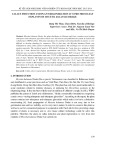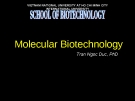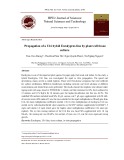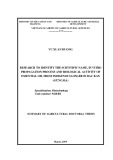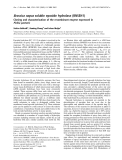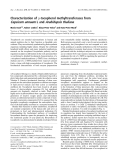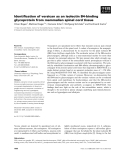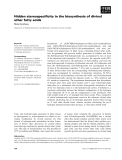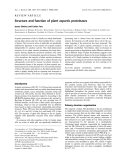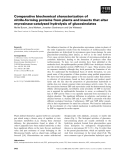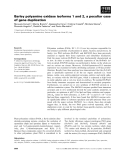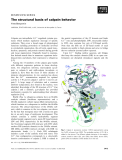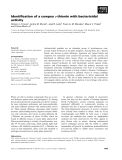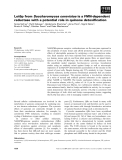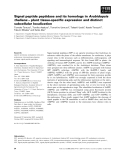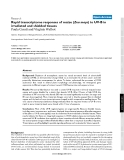
Tissues of plants
-
Seed propagation of Mycetia balansae Drake is not easy, due to low germination rate and low viability, so it is very rare in nature. In order to conserve this plant as well as to use for commercial purposes in cooperation with Tue Linh Co.Ltd, providing a large number of plants is necessary and in vitro tissue culture technology could be solve this problem. Therefore, the study on "Callus induction and plant regeneration in vitro from leaf explants of mycetia balansae drake" was carried out.
 8p
8p  xuanphongdacy09
xuanphongdacy09
 29-09-2024
29-09-2024
 4
4
 1
1
 Download
Download
-
An applied field of biology that involves the use of living organisms and bioprocesses in engineering, technology, medicine and other fields requiring bioproducts. (http://en.wikipedia.org/wiki/Biotechnology) It is the products and exploitation from other fundamental sciences.Traditional Biotechnology Traditional biotechnology refers to a number of ancient ways of using living organisms to make new products or modify existing ones. In its broadest definition, traditional biotechnology can be traced back to human's transition from hunter-gatherer to farmer.
 29p
29p  zingzing09
zingzing09
 24-04-2013
24-04-2013
 68
68
 9
9
 Download
Download
-
Polymerase Chain Reaction is widely held as one of the most important inventions of the 20th century in molecular biology. Small amounts of the genetic material can now be amplified to be able to a identify, manipulate DNA, detect infectious organisms, including the viruses that cause AIDS, hepatitis, tuberculosis, detect genetic variations, including mutations, in human genes and numerous other tasks.
 62p
62p  zingzing09
zingzing09
 24-04-2013
24-04-2013
 58
58
 7
7
 Download
Download
-
Glofish is the first transgenic animal approved to be consumed by human in the USA The insertion of different constructs of GFP into the fish genomes to give different green colors.The idea for recombinant DNA was first proposed by Peter Lobban, a graduate student of Prof. Dale Kaiser in the Biochemistry Department at Stanford University Medical School. The first publications describing the successful production and intracellular replication of recombinant DNA appeared in 1972 and 1973.
 54p
54p  zingzing09
zingzing09
 24-04-2013
24-04-2013
 79
79
 6
6
 Download
Download
-
Eucalyptus is one of the important plant species for paper pulp, fuel wood, and timber. In this study, a hybrid Eucalyptus, U16 line, was investigated for rapid in vitro propagation. The apical and adventitious shoots served as initial explants.
 8p
8p  viprimi
viprimi
 16-12-2024
16-12-2024
 2
2
 1
1
 Download
Download
-
To identify species, biological traits, chemical composition, and bioactive activities of essential oil and to develop propagation technical process using tissue culture techniques from shoot bud cutting to contribute to the conservation and development of genetic sources of native ginger plants in Bac Kan.
 27p
27p  trinhthamhodang7
trinhthamhodang7
 31-08-2020
31-08-2020
 52
52
 2
2
 Download
Download
-
Insect pests and pathogens (fungi, bacteria and viruses) are responsible for severe crop losses. Insects feed directly on the plant tissues, while the pathogens lead to damage or death of the plant. Plants have evolved a certain degree of resistance through the production of defence compounds, which may be aproteic, e.g. antibiotics, alkaloids, terpenes, cyanogenic glucosides or proteic, e.g. chitinases,b-1,3-glu-canases, lectins, arcelins, vicilins, systemins and enzyme inhibitors.
 16p
16p  research12
research12
 23-04-2013
23-04-2013
 46
46
 3
3
 Download
Download
-
Epoxide hydrolase (EC 3.3.2.3) in plants is involved in the metabolism of epoxy fatty acids and in mediating defence responses. We report the cloning of a full-length epoxide hydrolase cDNA (BNSEH1) from oilseed rape (Brassica napus) obtained by screening of a cDNA library prepared frommethyl jasmonate induced leaf tissue, and the5¢-RACE technique. The cDNA encodes a soluble protein containing 318 amino acid residues.
 8p
8p  tumor12
tumor12
 22-04-2013
22-04-2013
 34
34
 3
3
 Download
Download
-
Tocopherols are essential micronutrients in human and animal nutrition due to their function as lipophilic anti-oxidants. Theyare exclusively synthesizedbyphotosynthetic organisms including higher plants. Despite the attributed beneficial health effects and many industrial applications, research on the tocopherol biosynthetic pathway and its regulation inplants is still limited.
 9p
9p  tumor12
tumor12
 20-04-2013
20-04-2013
 42
42
 4
4
 Download
Download
-
Nociceptors are specialized nerve fibers that transmit noxious pain stimuli to the dorsal horn of the spinal cord. A subset of nociceptors, the nonpepti-dergic C-fibers, is characterized by its reactivity for the plant isolectin B4 (IB4) from Griffonia simplicifolia. The molecular nature of the IB4-reactive glycoconjugate, although used as a neuroanatomical marker for more than a decade, has remained unknown.
 13p
13p  awards
awards
 05-04-2013
05-04-2013
 38
38
 4
4
 Download
Download
-
Incubations of [8(R)-2 H]9(S)-hydroperoxy-10(E),12(Z)-octadecadienoic acid, [14(R)-2 H]13(S)-hydroperoxy-9(Z),11(E)-octadecadienoic acid and [14(S)-2 H]13(S)-hydroperoxy-9(Z),11(E)-octadecadienoic acid were per-formed with preparations of plant tissues containing divinyl ether synth-ases.
 0p
0p  awards
awards
 05-04-2013
05-04-2013
 30
30
 2
2
 Download
Download
-
Little is known about the functions of DNA polymerasek (Pol k) recently identified in mammals. From the genomic sequence information of rice andArabidopsis, we found that Polkmay be the only member of the X-family in higher plants. We have succeeded in isolating the cDNA and recombinant protein of Polkin a higher plant, rice (Oryza sativaL. cv. Nipponbare) (OsPolk). OsPolkhad activities of DNA polymerase, terminal deoxyribonucleotidyl trans-ferase and deoxyribose phosphate lyase, a marker enzyme for base excision repair. ...
 9p
9p  dell39
dell39
 03-04-2013
03-04-2013
 54
54
 3
3
 Download
Download
-
Aspartic proteinases of the A1 family are widely distributed among plant species and have been purified from a variety of tissues. They are most active at acidic pH, are specifically inhibited by pepstatin A and contain two aspartic residues indispensible for catalytic activity. The three-dimensional structure of two plant aspartic proteinases has been deter-mined, sharing significant structural similarity with other known structures of mammalian aspartic proteinases.
 9p
9p  dell39
dell39
 03-04-2013
03-04-2013
 38
38
 3
3
 Download
Download
-
The defensive function of the glucosinolate–myrosinase system in plants of the order Capparales results from the formation of isothiocyanates when glucosinolates are hydrolysed by myrosinases upon tissue damage. In some glucosinolate-containing plant species, as well as in the insect herbivore Pieris rapae, protein factors alter the outcome of myrosinase-catalysed glu-cosinolate hydrolysis, leading to the formation of products other than isothiocyanates.
 15p
15p  inspiron33
inspiron33
 26-03-2013
26-03-2013
 54
54
 5
5
 Download
Download
-
Polyamine oxidases (PAOs, EC 1.5.3.11) are key enzymes responsible for the terminal catabolism of polyamines in plants, bacteria and protozoa. In barley, two PAO isoforms (HvPAO1 and HvPAO2) have been previously analyzed as regards their tissue expression and subcellular localization.
 13p
13p  inspiron33
inspiron33
 25-03-2013
25-03-2013
 50
50
 5
5
 Download
Download
-
Calpains are intracellular Ca 2+ -regulated cysteine pro-teases which mediate regulatory cleavage of specific substrates. They cover a broad range of physiological functions including proteolysis of molecules involved in cytoskeletal organization, the cell cycle, signal trans-duction, apoptosis, and protein renewal during growth and tissue regeneration. Originally found in mamma-lian skeletal muscle then in numerous organisms inclu-ding protists and plants, their expression is ubiquitous [1,2].
 2p
2p  inspiron33
inspiron33
 25-03-2013
25-03-2013
 43
43
 4
4
 Download
Download
-
Antimicrobial peptides are an abundant group of proteinaceous com-pounds widely produced in the plant kingdom. Among them, thec-thionin family, also known as plant defensins, represents one typical family and comprises low molecular mass cysteine-rich proteins, usually cationic and distributed in different plant tissues.
 9p
9p  inspiron33
inspiron33
 25-03-2013
25-03-2013
 34
34
 4
4
 Download
Download
-
NAD(P)H:quinone acceptor oxidoreductases are flavoenzymes expressed in the cytoplasm of many tissues and afford protection against the cytotoxic effects of electrophilic quinones by catalyzing a strict two-electron reduc-tion. Such enzymes have been reported from several mammalian sources, e.g. human, mouse and rat, and from plant species.
 12p
12p  galaxyss3
galaxyss3
 21-03-2013
21-03-2013
 41
41
 3
3
 Download
Download
-
Signal peptide peptidase (SPP) is an aspartic proteinase that hydrolyses its substrate within the plane of the cellular membrane. In vertebrates, it plays crucial roles in life processes such as differentiation, embryogenesis, cell signaling and immunological response. We first found SPP in plants. An ortholog of human SPP (AtSPP), and its five AtSPP homologs (AtSPPL1– AtSPPL5), were searched for in theArabidopsisdatabase.
 10p
10p  media19
media19
 05-03-2013
05-03-2013
 41
41
 3
3
 Download
Download
-
1 March 2004 Genome Biology 2004, 5:R16 The electronic version of this article is the complete one and can be found online at http://genomebiology.com/2004/5/3/R16 Received: 27 October 2003 Revised: 15 December 2003 Accepted: 22 January 2004 © 2004 Casati and Walbot; licensee BioMed Central Ltd. This is an Open Access article: verbatim copying and redistribution of this article are permitted in all media for any purpose, provided this notice is preserved along with the article's original URL. B fluence ratesof skin cancer and has raised terrestrial levels of ultraviolet-Bfor plants....
 0p
0p  thulanh21
thulanh21
 15-11-2011
15-11-2011
 63
63
 2
2
 Download
Download
CHỦ ĐỀ BẠN MUỐN TÌM









